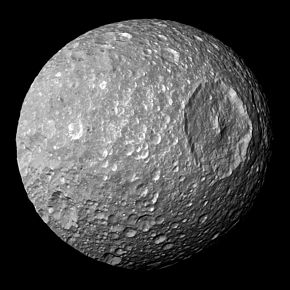
Mimas
Moon of Saturn / From Wikipedia, the free encyclopedia
Dear Wikiwand AI, let's keep it short by simply answering these key questions:
Can you list the top facts and stats about Mimas (moon)?
Summarize this article for a 10 year old
Mimas, also designated Saturn I, is the seventh-largest natural satellite of Saturn. With a mean diameter of 396.4 kilometres or 246.3 miles, Mimas is the smallest astronomical body known to be roughly rounded in shape due to its own gravity. Mimas's low density, 1.15 g/cm3, indicates that it is composed mostly of water ice with only a small amount of rock, and study of Mimas's motion suggests that it may have a liquid ocean beneath its surface ice. The surface of Mimas is heavily cratered and shows little signs of recent geological activity. A notable feature of Mimas's surface is Herschel, one of the largest craters relative to the size of the parent body in the Solar System. Herschel measures 139 kilometres (86 miles) across, about one-third of Mimas's mean diameter,[10] and formed from an extremely energetic impact event. The crater's name is derived from the discoverer of Mimas, William Herschel, in 1789. The moon's presence has created one of the largest 'gaps' in Saturn's ring, named the Cassini Division, due to orbital resonance destabilizing the particles' orbit there.
 | |
| Discovery | |
|---|---|
| Discovered by | William Herschel |
| Discovery date | 17 September 1789[1] |
| Designations | |
Designation | Saturn I |
| Pronunciation | /ˈmaɪməs/[2] or as Greco-Latin Mimas (approximated /ˈmiːməs/) |
Named after | Μίμας Mimās |
| Adjectives | Mimantean,[3] Mimantian[4] (both /mɪˈmæntiən/) |
| Orbital characteristics [5] | |
| Periapsis | 181902 km |
| Apoapsis | 189176 km |
| 185539 km | |
| Eccentricity | 0.0196 |
| 0.942421959 d | |
Average orbital speed | 14.28 km/s (calculated) |
| Inclination | 1.574° (to Saturn's equator) |
| Satellite of | Saturn |
| Physical characteristics | |
| Dimensions | 415.6 × 393.4 × 381.2 km (0.0311 Earths)[6] |
Mean radius | 198.2±0.4 km [6][7] |
| 490000–500000 km2 | |
| Volume | 32600000±200000 km3 |
| Mass | (3.75094±0.00023)×1019 kg [7] (6.3×10−6 Earths) |
Mean density | 1.1501±0.0070 g/cm3[7] |
| 0.064 m/s2 (0.00648 g) | |
| 0.159 km/s | |
| synchronous | |
| zero | |
| Albedo | 0.962±0.004 (geometric)[8] |
| Temperature | ≈ 64 K |
| 12.9 [9] | |